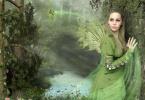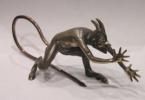Views: 9723
23.03.2017
Do you know why tsunamis, tornadoes, typhoons and other disasters carrying people misfortune and misfortune are called beautiful female names? Because hurricanes affectionate names, since ancient times (this applies to our unconscious instincts) seem less creepy and more manageable. People implicitly believe that if you call a natural disaster a harmonious and pleasant word, then they will thus have the opportunity to influence it. Illusion. Not in this case.
Just by rewarding a malicious beetle nice name Alenka, we, unfortunately, can neither appease him nor control him.
What kind of animal?
Alenka hairy or bronze (Epicometis hitra Poda) – dangerous insect, which over the past few years has literally terrorized Ukrainian gardeners.

Flower beetle. Gnawing out inflorescences on fruit trees, shrubs, flowers, other cultivated plants.
Belongs to the class of May beetles, although the larva does not feed on the roots of fruit and berry crops, as is customary with other brethren.
The body length of the pest reaches one and a half centimeters, the color of the wings is black, matte texture. There are white spots on the elytra. Basic hallmark beetle is its inherent shaggy body.
Has the ability to fly from place to place. Has an unpleasant smell.
Scientists suggest that Asia is the birthplace of the beetle, and due to natural changes favorable for it, which are associated primarily with increased solar activity, the insect migrated to our latitudes.
Winters in the soil at a depth of fifteen to forty centimeters. Burrows into the ground in the cold, as well as at night (to a depth of one centimeter) and during rain. When the average daily temperature rises to fourteen degrees (the period, as a rule, coincides with the violent flowering of dandelions), it crawls out of the shelter, starts years and immediately starts devouring flowers. Eats petals, pistils and stamens on magnolias, peonies, tulips. Then it moves to fruit trees.
At the time of formation of inflorescences, it harms apple trees, pears, apricots, cherries, cherries, and strawberries.
Especially a lot of the beetle is concentrated in collective horticultural farms and on summer cottages. The mass years last until the middle of June. After flowering of fruit trees, it flies to cereal crops.
At the end of June, females begin to lay eggs, and well-fertilized soil is selected for laying, as a rule, choosing places with humus.
pest control
Fighting the furry Alenka is not easy. Still effective means to combat this insect.
One of the most effective ways confrontation with an adult beetle is the chemical treatment of the land under fruit trees. Previously used for this different kinds dusts, in particular hexachloran and preparations based on arsenic and fluorine. But in view of the high toxicity, these chemicals are currently banned and not used.
So far, the most environmentally sound method of pest control is the usual shaking of branches on flowering trees in order to knock insects to the ground. This procedure must be performed in the early morning, after covering the tree bed with a film, tarpaulin or other bedding.
After collecting the beetles, they must be destroyed. This method works if done regularly, because, as beetles fly, and in a day or two, new uninvited guests will appear in the garden. It is recommended to pre-spray tree branches before shaking. cold water. In this case, the beetles lose their ability to fly and the chances of a successful hunt increase.

Gardeners have long noticed a phenomenon inexplicable by science: Alenka “loves” shades of blue and purple. To this end, they recommend garden plot, next to fruit trees, place dishes (buckets, bowls) of the above colors, using them as bait for beetles. In these containers filled with water, Alenka falls into a trap.
It is important to remember about preventive measures to combat the beetle, for which in the fall it is necessary to carefully remove and burn the fallen leaves.
Many gardeners successfully use Calypso SC by applying the solution directly to the near-stem circles of fruit trees.
Another of the most promising and ecological ways to deal with the beetle is breeding (luring) birds, especially starlings, as well as magpies, rooks, orioles, hoopoes and others.
Unfortunately, insecticides for the control of Alyonka in the imago stage are not effective, and the larvae of the beetle are fought with the same methods as with the larvae of other beetles of the family, including the wireworm.
It is impossible to process flowers directly on trees with chemistry, since in this way it is possible to destroy beneficial insects pollinating flower buds and bees including.
Bronzovka hairy (Alenka hairy): how to fight? Destroys all the color on fruit trees and bushes in a matter of hours, thereby leaving gardeners without a future harvest. The fight against Alenka shaggy is difficult. What does Alenka furry love? "Feast" (apply substantial harm) Alenka hairy comes to the surface during the flowering of dandelions and coltsfoot. Then it begins to eat petals and stamens on tulips, irises, daffodils, magnolias, peonies. And when the flowering of apple trees, apricots, cherries, cherries, pears, peaches and other stone fruits begins, strawberries fly over to them. How to deal with Alenka hairy? 1. The fight must begin even before the flowering of the garden - soil treatment with chemicals under the trees. 2. When Alenka hairy appears, treat the soil with hexachloran dust (deepen chemical drug to a depth of 3-5 cm). When the pest penetrates the soil at night, there will be a collision with a pesticide and, as a result, death. However, this method was used back in the distant 50s, now such use is environmentally friendly. hazardous substances unacceptable. 3. Make birdhouses on the site, attract and lure birds - a great way to deal with Alenka hairy, one of the key pest control methods. The lovers of this pest are the common starling, magpie, rooks, oriole, hoopoe, cones funnel and others. 4. Collecting bronze beetles by hand is very effective method struggle, but difficult with a mass appearance. 5. Shaking off trees onto a tarp or polyethylene film with further destruction. Before shaking off, pour cold water on the tree so that the bronze beetles settle and cannot take off. 6. One of the less effective measures in the fight is spraying trees with insecticides, since jumping should be done during the day, when the pest is on the trees, and many drugs are forbidden to use when high temperature and under the influence of sunlight. Gardeners can treat trunk circles with insecticides when the beetles are inactive (early morning, cool weather). 7. Spray up to three times every 7 days with preparations aimed at combating the Colorado potato beetle (Aktara). 8. Experiments of scientists have shown that Alenka shaggy is attracted by the blue color, so make traps. Near each tree, you can put a blue container with water diluted with actara 240SC, decis pro or calypso 480SC. Calypso 480SC can be sprayed on trees if there are a small number of Alenok on it. Just do not dress in blue yourself, there is a chance that you yourself will become the object of invasion! In practice, this method of dealing with Alenka shaggy causes conflicting reviews. However, it is worth recognizing the fact that there is still NO “magic pill” in the fight against Alenka shaggy, the pest can be compared with Tatar-Mongol yoke(they flew in, ate, flew away).
Spring is coming - the time when nature comes to life, awakens after a long winter sleep. However, with the first plants, insect pests appear that feed on them. One of the first to emerge from wintering is the hairy bronze beetle, known to many gardeners as the hairy deer. This is a malicious pest that eats the buds, flowers and ovaries of many plants. Considering the massive invasion of bronze last year, it is advisable to prepare in advance to fight it.
The deer belongs to the genus lamellar and is a relative of the well-known May beetle. The adult insect is relatively small - 8-13 mm in length, the body is dull black with white or yellowish spots, the pattern of which is very variable. However, the main morphological feature, due to which the hairy deer got its name, is the presence of grayish-yellow hairs on its body: sparse on the back, and thick and long on the abdomen, especially on the sides.
It hibernates in the ground, in the phase of an adult insect. The first representatives of this species begin to feed already in the second decade of March. First, the deer feeds on dandelion flowers and buds, coltsfoot, irises, and then flies to a blooming garden.
As a result, flowers and buds fall off, the tree does not bear fruit. This pest feeds on clear sunny days, and at night, during rain and cold, it hides in the ground. The deer is a polyphagous, therefore damaging a lot flowering plants and has a very good appetite.

The harmfulness of this insect during the years of mass reproduction is colossal. Having finished eating, it lays eggs in nutritious moist soil, dung heaps and rotting parts of plants. The eggs hatch into thick, curved larvae that feed on humus and other decaying lean residues. Having finished feeding, the larva creates an earthen cocoon in which it pupates. The young formed beetle remains in a cocoon for the winter.
pest control
It is possible to fight this pest both mechanically and chemically. If the number of insects is small, pesticides can be dispensed with; if your site was subjected to a mass attack, a set of measures will help best of all.
Mechanical methods include the destruction of adult beetles by manual collection or shaking them off. flowering trees onto polyethylene film and then incinerated. So that insects do not scatter, before this, the tree should be treated with cool water. Also, the simplest traps will help in the fight against deer - purple or blue containers with water, placed around the site.
Do not forget about tillage. Solid plowing in the spring will help to reduce the population of the species, as well as plowing during the development of larvae and pupae. In addition, it is very important to collect carrion and rotted leaves in time, in which larvae develop. Another one of the environmentally friendly methods of pest control is to attract insectivorous birds to the garden.
Against the hairy deer, insecticides of contact and intestinal action are used, which are introduced into the soil during the period of pupation and oviposition (Vallar, Aktara). During the feeding period, the beetles are sprayed with Calypso and Biscay preparations.
No less voracious pest is the May beetle. It is also classified as a lamellar, and they have a lot in common with the hairy deer. The May beetle (Khrushch) is a large insect (22-29 mm) with a black body and reddish-brown wings. The larva of the beetle is yellowish-white, fleshy, up to 60 mm long. Lives in the ground younger age feeds on humus, then eats the roots of plants.

Fighting the Maybug
A damaged plant wilts, the leaves may curl up a little. In the fourth year of existence, the larva pupates and after a month and a half turns into an adult. As a rule, the young beetle remains to winter in the soil.
The given pest should be dealt with in a complex way: resort not only to chemicals protection, but also to physical and agrotechnical ones. This is, first of all, the preparation of the soil before planting, including deep digging. A good effect is the cultivation of rapeseed or mustard. They are grown to the phase of green beans, then, without removing, they dig up the site.
These plants are poisonous to the beetle, and will also serve as a wonderful fertilizer. Before planting, it is possible to introduce ammonia water into the soil (2 t / ha) - this is often practiced on industrial plantations. In such cases, the fertilized area should be kept clear of any vegetation all summer.
May beetle larvae prefer to settle in dung heaps, therefore in early spring humus should be shoveled. Insect larvae not adapted to low temperatures die.

On the eve of planting, the roots of the plant are dipped into a mixture of Aktara substance (0.5%); 8-9 days before planting, the soil is treated with Force (0.12 kg / weave) or Bazudin is applied to each planting hole.
It is also possible to use insecticides during the growing season. They are applied by irrigation under the root of the plant. Among the most used are Aktara 25ShS and Antikhrushch. When using them, you should carefully read the instructions and wait the indicated time between processing and harvesting.
Hello dear readers! Today I will introduce you to the beetle of the lamellar family, which belongs to the group, and share information on how to deal with hairy alenka. It's nice to watch when dandelions bloom with a yellow carpet, and with them coltsfoot. And at the same time, a polyphagous pest gets out to the surface and waits for the gardens to bloom,
to feast on buds, flowers, ovaries and young leaves of various deciduous, woody, and shrubby species, at the same time harming herbaceous plants and root crops.
The hairy alyonka causes the greatest harm during the flowering of gardens, and it is at this time that the mating period passes for the beetles. Flowering trees and shrubs in gardens during the years of the mass appearance of beetles are in great danger of being left without stamens and pistils in just a day. These bronzes breed very strongly in dry years. After the fruit trees fade, the beetles are reorganized to eat the flowers of cereals, cabbage and other crops.
Eggs are laid in the soil in areas rich in humus. The emerging larvae receive food in the form of organic residues in the soil. Dead roots, humus - everything suits them for food. The future beetle is in the larval stage for two months. Before pupation, the larva glues an oval-shaped cocoon from the ground and, after 2-3 days, transforms into a pupa. And in this form, the beetles hibernate, and in the spring they climb to the surface.
The fight against the hairy alenka is not easy, and it is difficult to fight it because the maximum activity of the beetle and the active flowering of gardens coincide in time. If the garden is sprayed at this time, as a result, not only bronzes will be destroyed, but also pollinators of the garden.
In addition, beetles do their dirty work only in daytime when the bulk of chemicals are not used, because elevated temperatures and solar Activity negate their effectiveness. You can, as an exception, try to process trunk circles insecticides in the early morning, in cool weather, that is, during low beetle activity. In this way, beetles that hide in the soil at night can be destroyed.
To obtain the desired effect from spraying, it must be repeated three times every 7 days with Calypso preparations (by the way, acquaintances who do not disdain to treat potato plantings with poisons are very pleased with this insecticide as an effective means of destruction - we, as you know, from Colorado we are saved), Aktar and others, with the help of which they fight against leaf-eating pests, until the bronzes completely disappear. Such spraying begins even before the gardens bloom en masse.
It is believed that flowers with a bright color (red, blue, purple) do not damage the hairy alenka. On the other hand, there is information that bronze, on the contrary, prefers purple and blue colors (although this information is not confirmed).
Based on the foregoing, it is recommended to place containers with water, using it as traps. As with, the mechanical method of dealing with bronzes by continuous digging is very effective. This greatly reduces the number of pests.
In small gardens, the beetle is shaken directly onto a tarp in the morning, as well as in cloudy and cool weather (that is, when their activity is greatly reduced). Collecting bugs by hand is also quite effective method, but in a period of mass appearance, this is very difficult to do.
And remember: our feathered friends love to eat bronzes, so try to attract birds to your gardens. Whoever has chickens, you can let them walk in the garden in the morning under the trees, from which you shake the beetles. And the trees benefit, and the chickens - a protein treat.
I wish you that your garden is not touched by any pests, and the harvests are always pleasing! See you soon, dear friends!
With all respect, Andrew!
Enter your e-mail and receive new articles by mail:


Biology, lifestyle and nutritional patterns
On warm sunny days, beetles feed mainly on color. various plants- weeds, wild-growing shrub species, gnawing pistil and ovary. Among perennial herbaceous plants prefer the borage family. These are all types of honeydew - medicinal, soft and dark. luxury flowers honeydews are collected in curls on the tops of the stems, they are clearly visible, with bell-shaped cups. Lungworts vegetate from the third decade of March and well attract adults of Alenka.
Intensively attract phytophages and flowering bushes wild rose, in particular May, apple and wrinkled. Rosehip flowers are large, with five rose petals in the middle of which a large number of stamens. It is often necessary to observe the accumulation of 3-4 phytophagous adults on one flower during 2-3 weeks of flowering (May), since some of the dog rose species are used in cultivation to obtain valuable fruits and create green hedges.

In the photo, the pest Alenka Mokhnataya
Natural enemies of Alenka Shaggy
During the period of diapause, 34–65% of the population of Alenka Mokhnataya perishes. Reason - low temperatures, flooding, and intense predator activity. During the period of development of the Alenka population, it is destroyed, first of all, by predatory turuns and rove beetles (28–60% of eggs, larvae and pupae). Alenka larvae and pupae are integral part diet of vertebrates such as moles, dormice, field mice and other rodents.

In the photo, the larva of Alenka Shaggy
In some years, a fairly significant part of larvae, pupae and adults die as a result of infection with entomopathogenic fungi - white, pink and green muscardine. With prolonged soil moisture, sudden temperature changes, it is affected by fungal pathogens and 9–26% of the Alenka population dies.
Imago weight indicators predetermine the physiological state, which determines the choice optimal places for diapausing and wintering. The effective part of the Alenka population is concentrated on the soil surface and in the soil at a depth of up to 5 cm, which is 66.1%. This is where they are created optimal conditions for overwintering beetles. It is also obvious that physiologically weakened populations, and this is more than 19%, as a rule, die under the influence of various stress factors over a long period of diapause. This is a kind of prey for numerous populations of predatory arthropods.
Small area protection
There is perhaps the only one quite effective reception mass destruction of Alenka, which is based on such a feature of its biology as the intense pubescence of adults with thick hairs. The essence of the reception lies in the fact that during the period of mass settlement of bushes or plants by Alenka, they are sprayed with clean river water throughout the day, when the beetles are most active. Drops of water concentrate on the hairs, as a result of which the beetles lose their motor and flight activity.
After a few minutes, they are shaken off onto plastic wrap, collected and destroyed. With a high number of pests, this technique must be carried out several times a day. It is clear that this method can only be used in private and summer cottages.
Farm protection
Specific environmental conditions of research sites - significant species diversity wild shrub and herbaceous nectarifers, plantations cultivated plants, with a predominance of berries - in the aggregate, all this the necessary conditions for the development and distribution of Alenka. The peculiar natural landscape that took place in the study area (the presence of steep hills and lowlands) excluded active economic activity. Maximum solar insolation also contributed to the spread and development of the pest population.
Long-term studies were carried out mainly in blackcurrant agrocenoses. It has been experimentally established that the distribution of a pest is a typical example of the development of ecological niches by a species, the biotic potential of which is limited only by the trophic resource.
In private and summer cottages, it is necessary to destroy Alenka's wintering places - aisles, field edges, by loosening and digging the soil and raking the leaf layer with its subsequent disposal.
As operational measures aimed at protecting, first of all, berries, garden plantations and vegetables, it is proposed to use domestic entomopathogenic drugs Boverina 3.0% c. With. and Pecilomina 3.0% c. With… Aqueous solution preparations are treated with places of mass accumulation of adults of Alenka. Under the action of the preparations fall eggs, larvae, pupae and diapausing adults of the pest.
The results indicate that biological preparations were the main cause of the death of almost all stages of development of the pest. Long-term contact (over 6 months) of entomopathogenic fungi from adults of Alenka led to the death of 74–83% of the population. Abrupt changes temperatures and air humidity destabilized the physiological state of the population, which caused its massive infection with entomopathogens.
Since only one generation of Alenka develops during the growing season, treatment with preparations is carried out once during the period of mass migration of adults into the soil. Reception is quite technological, the preparations are characterized by indifferent action in relation to entomophages, non-toxic for entomophages and pollinating insects. This is evidence of the prospects of using this technology to protect berries and vegetables from Alenka Shaggy.
Video "Alenka Shaggy - a way to fight"




